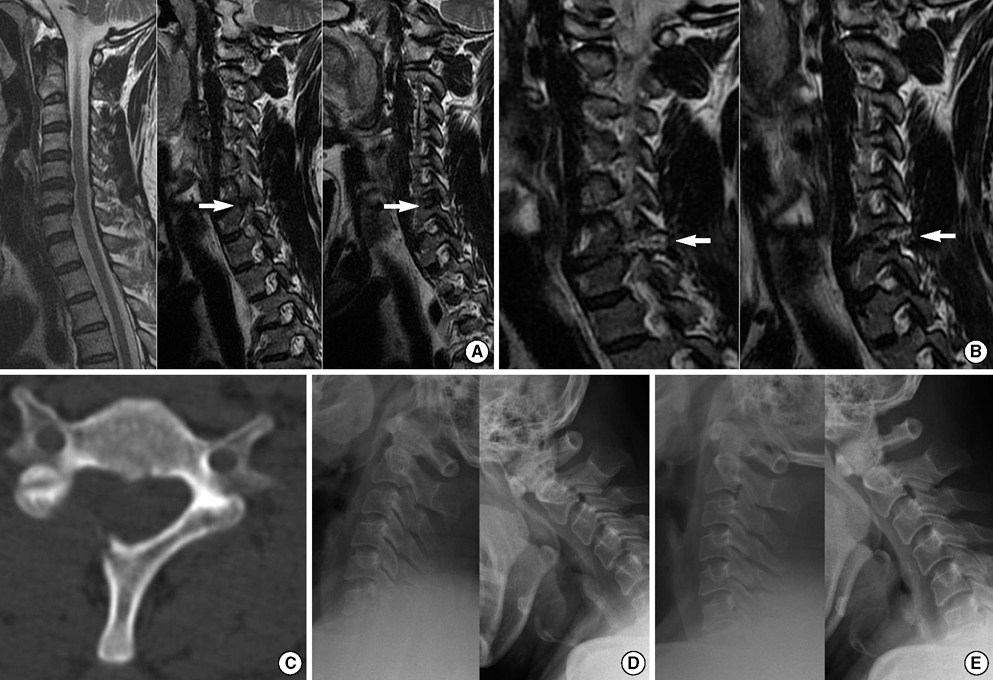J Korean Med Sci.
2009 Apr;24(2):302-306. 10.3346/jkms.2009.24.2.302.
Early Outcome of Posterior Cervical Endoscopic Discectomy: An Alternative Treatment Choice for Physically/Socially Active Patients
- Affiliations
-
- 1Department of Neurosurgery, Seoul National University Hospital, Seoul, Korea. chungc@snu.ac.kr
- 2Department of Neurosurgery, Seoul National University Bundang Hospital, Seongnam, Korea.
- 3Neuroscience Research Institute, Seoul National University Medical Research Center, Seoul, Korea.
- 4Clinical Research Institute, Seoul National University Hospital, Seoul, Korea.
- 5Department of Neurosurgery, The Armed Forces Capital Hospital, Seongnam, Korea.
- KMID: 1779134
- DOI: http://doi.org/10.3346/jkms.2009.24.2.302
Abstract
- Anterior cervical discectomy and fusion (ACDF) is currently the standard treatment for cervical disc disease. Some patients wish to be treated with a less invasive method, because of their social/physical situations. Here we present one method of treatments for socially/physically active patients. Three patients had triceps weakness and mild posterior neck pain. The offending lesions were at the C6-7 level. All were middle-aged soldiers with families. If conventional ACDF were performed, they would have to retire from the military according to the regulation. They had to be able to perform military drills after the treatment if they were going to be able to keep their jobs. Because of their social/physical situations, all wanted to choose method with that they could treat the disease and keep their jobs. For these reasons, the posterior cervical endoscopic discectomies were performed. Ruptured fragments were successfully removed in all. The arm pain improved by more than 90% in two patients by 7 days and in the other patient by 2 months, respectively (excellent outcome by Macnab's criteria). None of the operations caused instability. All of the patients are currently able to successfully perform their military drills without difficulty. The posterior cervical endoscopic discectomy may be a promising alternative for the physically/socially active patients.
Keyword
MeSH Terms
Figure
Reference
-
1. Cağlar YS, Bozkurt M, Kahilogullari G, Tuna H, Bakir A, Torun F, Ugur HC. Keyhole approach for posterior cervical discectomy: experience on 84 patients. Minim Invasive Neurosurg. 2007. 50:7–11.
Article2. Ruetten S, Komp M, Merk H, Godolias G. A new full-endoscopic technique for cervical posterior foraminotomy in the treatment of lateral disc herniations using 6.9-mm endoscopes: prospective 2-year results of 87 patients. Minim Invasive Neurosurg. 2007. 50:219–226.
Article3. Chang UK, Kim DH, Lee MC, Willenberg R, Kim SH, Lim J. Range of motion change after cervical arthroplasty with ProDisc-C and prestige artificial discs compared with anterior cervical discectomy and fusion. J Neurosurg Spine. 2007. 7:40–46.
Article4. Choi G, Lee SH, Bhanot A, Chae YS, Jung B, Lee S. Modified transcorporeal anterior cervical microforaminotomy for cervical radiculopathy: a technical note and early results. Eur Spine J. 2007. 16:1387–1393.
Article5. Ahn Y, Lee SH, Lee SC, Shin SW, Chung SE. Factors predicting excellent outcome of percutaneous cervical discectomy: analysis of 111 consecutive cases. Neuroradiology. 2004. 46:378–384.
Article6. Ahn Y, Lee SH, Shin SW. Percutaneous endoscopic cervical discectomy: clinical outcome and radiographic changes. Photomed Laser Surg. 2005. 23:362–368.
Article7. Lee SH, Lee JH, Choi WC, Jung B, Mehta R. Anterior minimally invasive approaches for the cervical spine. Orthop Clin North Am. 2007. 38:327–337.
Article8. Frempong-Boadu A, Houten JK, Osborn B, Opulencia J, Kells L, Guida DD, Le Roux PD. Swallowing and speech dysfunction in patients undergoing anterior cervical discectomy and fusion: a prospective, objective preoperative and postoperative assessment. J Spinal Disord Tech. 2002. 15:362–368.
Article9. Jung A, Schramm J, Lehnerdt K, Herberhold C. Recurrent laryngeal nerve palsy during anterior cervical spine surgery: a prospective study. J Neurosurg Spine. 2005. 2:123–127.
Article10. Haufe SM, Mork AR. Complications associated with cervical endoscopic discectomy with the holmium laser. J Clin Laser Med Surg. 2004. 22:57–58.
Article11. Jho HD. Microsurgical anterior cervical foraminotomy for radiculopathy: a new approach to cervical disc herniation. J Neurosurg. 1996. 84:155–160.
Article12. Jho HD, Kim WK, Kim MH. Anterior microforaminotomy for treatment of cervical radiculopathy: part 1--disc-preserving "functional cervical disc surgery". Neurosurgery. 2002. 51:5 Suppl. S46–S53.
Article13. Hong WJ, Kim WK, Park CW, Lee SG, Yoo CJ, Kim YB, Jho HD. Comparison between transuncal approach and upper vertebral transcorporeal approach for unilateral cervical radiculopathy-a preliminary report. Minim Invasive Neurosurg. 2006. 49:296–301.14. Gala VC, O'Toole JE, Voyadzis JM, Fessler RG. Posterior minimally invasive approaches for the cervical spine. Orthop Clin North Am. 2007. 38:339–349.
Article15. O'Toole JE, Sheikh H, Eichholz KM, Fessler RG, Perez-Cruet MJ. Endoscopic posterior cervical foraminotomy and discectomy. Neurosurg Clin N Am. 2006. 17:411–422.16. Riew KD, Cheng I, Pimenta L, Taylor B. Posterior cervical spine surgery for radiculopathy. Neurosurgery. 2007. 60:1 Suppl 1. S57–S63.
Article
- Full Text Links
- Actions
-
Cited
- CITED
-
- Close
- Share
- Similar articles
-
- Posterior Endoscopic Cervical Decompression: Review and Technical Note
- Endoscopic Spine Surgery
- Anterior Endoscopic Cervical Discectomy: Surgical Technique and Literature Review
- Transforaminal Endoscopic Surgery: Outside-In Technique
- Surgical Results of Posterior Laminoforaminotomy and Discectomy for Cervical Disc Herniation



